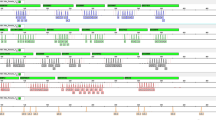Abstract
Short tandem repeat (STR) analysis provides genetic fingerprinting of individuals and is an indispensable technique for forensic human identification. Recently, this technique has been used in social areas, such as the identification of The Korean War, descendants of national merit, and missing children. STR analysis is performed by analyzing iteration number of repeating bases in the human genome, and currently FBI provides the Combined DNA Index System (CODIS) based on DNA databases. Among them, we used the autosomal short tandem repeats of loci D13S317, D16S539, D21S11, and amelogenin to validate this technique for identification. The samples were collected from unrelated 50 Korean individuals, and 4 STR loci of these samples were analyzed by ABI 3130 genetic analyzer. We demonstrated that 47 samples out of 50 were classified completely with only 4 STR markers, and perfect sex identification could be accomplished with amelogenin analysis.
Similar content being viewed by others
References
Carracedo, A. (2005) Forensic DNA typing protocols. pp. 1–11. In: A. Carracedo and P. Sanchez-Diz (eds.). Methods in molecular Biology: Forensic DNA Typing Protocols. Humana Press, Totowa, NJ, USA.
Hert, D. G., C. P. Frediake, and A. E. Barron (2008) Advantages and limitations of next-generation sequencing technologies: A comparison of electrophoresis and non-electrophoresis methods. Electrophoresis 23: 4618–4626.
Budowle, B. and A. van Daal (2009) Extracting evidence from forensic DNA analysis: future molecular biology directions. Bio-Techniques. 46: 339–350.
Lohmueller, K. E. (2010) Graydon et al. provide no new evidence that forensic STR loci are functional. Forensic Sci. Internat.: Gen. 4: 273–274.
Budowle, B., T. R. Moretti, A. L. Baumstark, D. A. Defenbaugh, and K. M. Keys (1999) Population data on the thirteen CODIS core short tandem repeat loci in African Americans, U.S. Caucasians, Hispanics, Bahamians, Jamaicans, and Trinidadians. J. Forensic Sci. 44: 1277–1286.
Ou, X., W. Chen, H. Chen, F. Zhao, J. Zheng, D. Tong, Y. Chen, A. Chen, and H. Sun (2011) Null alleles of the X and Y chromosomal amelogenin gene in a Chinese population. International J. Legal Med. 126: 513–518.
Budowle, B., B. Shea, S. Niezgoda, and R. Chakraborty (2001) CODIS STR loci data from 41 sample populations. J. Forensic Sci. 3: 453–489.
Cerri, N., M. Franchi, S. Mascadri, and F. De Ferrari (2003) Allele frequency distribution of 13 STRs in an Italian and immigrant population sample. Internat. Cong. Series. 1239: 137–143.
Francez, P. A. C., E. M. R. Rodrigues, G. F. Frazão, N. D. dos Reis Borges, and S. E. B. dos Santos (2011) Allelic frequencies and statistical data obtained from 12 codis STR loci in an admixed population of the Brazilian Amazon. Genet. Mol. Biol. 34: 35–39.
Untoroa, E., D. S. Atmadjaa, C. -E. Pub, and F. -C. Wub (2009) Allele frequency of CODIS 13 in Indonesian population. Legal Med. 11: 203–205.
Lee, M. -H., S. Y. Park, D. J. Kim, M. -J. Kim, H. -M. Ryu, and Y. -H. Cho (2010) Genetic variation of three autosomal STR loci D21S1435, D21S1411, and D21S1412 in Korean population. Mol. Biol. Rep. 37: 99–104.
Hwa, H. -L, Y. -Y. Chang, J. -C. Lee, C. -Y Lin, H. -Y Yin, L. -H Tseng, Y. -N. Su, and T. -M. Ko (2012) Fifteen non-CODIS autosomal short tandem repeat loci multiplex data from nine population groups living in Taiwan. Int. J. Legal Med. 126: 671–675.
Yuan, L, J. Ge, D. Lu, and X. Yang (2012) Population data of 21 non-CODIS STR loci in Han population of northern China. Int. J. Legal Med. 4: 659–664.
Baba, Y. (1999) Capillary affinity gel electrophoresis: New technique for specific recognition of DNA sequence and the mutation detection on DNA. J. Biochem. Biophys. Methods 41: 91–101.
NIST Standard Reference Database, FBI CODIS Core STR Loci. http://www.cstl.nist.gov/strbase/index.htm.
Butler, J. M. (2006) Genetics and genomics of core short tandem repeat loci used in human identity testing. J. Forensic Sci. 51: 253–265.
Cybertory web page, Criminal DNA database. http://www.cybertory.org.
Author information
Authors and Affiliations
Corresponding author
Rights and permissions
About this article
Cite this article
Seo, SC., Lee, JY. & Won, JI. Validation of 4 type-STR analysis for identification of 50 Korean. Biotechnol Bioproc E 18, 663–668 (2013). https://doi.org/10.1007/s12257-012-0790-y
Received:
Revised:
Accepted:
Published:
Issue Date:
DOI: https://doi.org/10.1007/s12257-012-0790-y




